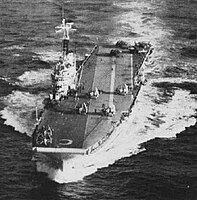HMS Centaur (R06)
|
HMS Centaur , 1955
|
||||||||||||||||||||
|
||||||||||||||||||||
|
||||||||||||||||||||
|
||||||||||||||||||||
|
||||||||||||||||||||
The British HMS Centaur (R06) was the first of four aircraft carriers of the Centaur class of the Royal Navy .
The keel of the ship was laid in 1944 at the Harland & Wolff shipyard in Belfast . After the end of the Second World War , construction was slow and the ship was not put into service until 1953. The aircraft carrier was equipped with a modified flight deck between 1956 and 1958, the landing area of which was angled 6 ° to the ship's axis. In addition, were steam catapults built in to the start of jet aircraft to allow.
history
The Centaur was laid down as the second ship of the Centaur class, but came into service before the Albion (R07) and thus became the lead ship of the class named after her. The keel was laid on May 30, 1944, and construction continued at normal speed until it was launched on April 22, 1947. After that, however , the Centaur was launched. Work did not resume until 1951.
On September 1, 1953, the Centaur first put into service. In the meantime, the aircraft carrier industry had revolutionized itself through spectacular developments such as angled deck, state mirror and steam catapult. After completing their test drives , Centaur went back to the shipyard for conversion. In February 1954 she finally got under way, the landing deck was now angled 5½ ° to port.
In the further course of her service, she received two steam catapults and a new rope catching system on the occasion of the shipyard layover 1956-1958 in order to remove all modern, at the time in service, or planned jet aircraft (" Sea Hawk ", " Sea Venom ", " Scimitar " and " Sea Vixen ") to be able to use.
Whereabouts
In the 1960s it became clear that it was not likely that the ship would remain in service for a longer period as a light fleet aircraft carrier . A new generation of aircraft was arriving, which in terms of size and weight could neither be accommodated in sufficient numbers nor used. Therefore, the conversion to a command ship based on the model of the sister ships Bulwark (R08) and Albion (R07) was temporarily considered , but there was neither an urgent need, nor were the necessary financial resources available. In 1965, after only eleven years of active fleet service , the Centaur was taken out of service as an aircraft carrier and used as a residential ship until 1972. It was deleted from the fleet list on April 24, 1970.
While Albion was decommissioned in 1972, Bulwark served as an ASW carrier until 1981 . The fourth sister ship Hermes (R12) was in service with the Indian fleet as INS Viraat (R22) until 2016 .
